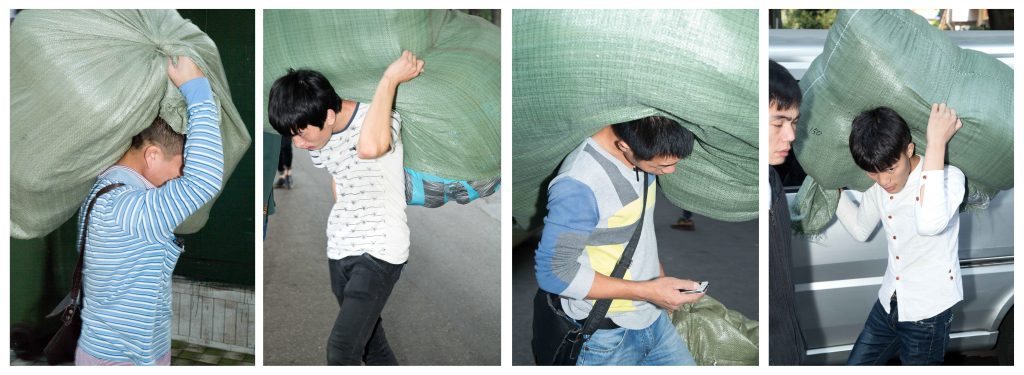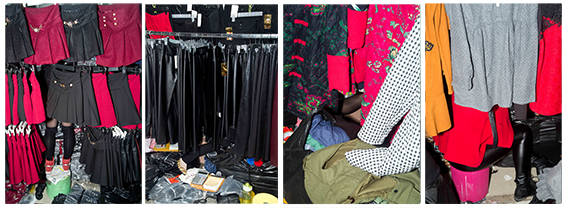‘A Trading Journey’, the exhibition by Alejandro Acin in a shipping container outside the M Shed Museum in Bristol in November, was well received. Since then, Alejandro, who is an assistant at the Historical Photographs of China project, has had the opportunity to return to Guangzhou (Canton) to continue his photographic project on key trading areas in the city. Here is Alejandro’s overview of his trip:
It was very nice to be back in Guangzhou, somehow I feel very connected to the city. Of course, taking photographs in a place makes me develop a special relationship with it, even if I’m there for only a short period of time, but there seems to be something else. Probably, it has to do with the activity in these markets and wholesale sheds, the flux of people and goods, the noise, the colours.
A second trip was needed to push my project forward. The materials I gathered on my first trip and the exhibition I did, helped me to clarify what I was looking for in this return journey but also to raise some questions about my discourse. On my first trip I had the chance to go to some of the most popular clothing wholesale markets near the South Railway Station. But this time, I was recommended by my friend Tao, a local photographer, to visit the Shaheding (沙河顶) and Yide Lu (一德路) areas, important wholesale clothes markets where international fashion brands identify the latest fashion trends which they will later include in their catalogues as their own designs. It seems the local government wants to close these wholesale markets, citing health and safety risks. However a real reason seems to be part of an urban rebranding strategy to make Guangzhou a new and modern city.
In a conversation with Du Huizhen, Lecturer in Journalism at Guangdong University of Foreign Studies, she pointed that China is shifting from being a global production provider to an international distributor – many factories are moving to other countries such us Bangladesh or India, where overheads are cheaper. Logistics are becoming very important in China, particularly in Guangzhou, and they are always looking for new ways that allow them to distribute more items in shorter period of time. Guangzhou is very popular in the distribution of clothes and clothing accessories. A large percentage of sales in these fashion wholesale markets are of course online. My friend Tao, told me that these wholesale markets used to be much more hectic in the past than they are now, a decline due to online trading.
To get a rough idea of the huge volume of these sales, the Singles Day sales (similar to Black Friday) are an extreme example. On these days, discounts for online products are offered by almost every company. This year, approximately 760 million packages were sent during the 24-hour period – 42 per cent more than last year, according to the state authority.
This phenomenon interests me greatly, not just the acts of consumerism but the human force behind the distribution and the physical relations with all of these goods. So during my second trip, I photographed porters. Porters are usually responsible for picking up the goods that were purchased online from the shops in the wholesale market and then taking them to the lorry or van waiting downstairs which will later go into a ship container. As you can image, the traffic of porters around these wholesalers is constant. I am very interested in the formal aspects of these images but also their capacity to generate questions about the aesthetics of consumerism.
As well as photographing porters I also walked inside the wholesale malls. Shaheding has malls with 4 or 5 floors. Every floor is full of stalls where the cloths are displayed. The shop assistants normally stand beside their stalls (because the stalls are fully packed with bags), wearing some of the outfits that they sell, so that they are living mannequins. The activity is frenetic, people carrying bags everywhere, shop assistants clapping to catch the attention of passers-by, food delivery trolleys … I was attracted by the ways that shop assistants create and use the storage space as personal private space.
On my last day, while I was walking around different second hand bookshops with my friend Hu, he found a photography book about international trading agreements with China, from 1950 to 1990. I have to admit, this could be a very boring photo book for some people, but I was fascinated by all the hand-shaking! My project was inspired by the Historical Photographs of China archive, in particular the images of trade in Canton a hundred years ago. With the hand-shaking photographs, I want to add a new layer to my project, looking at the imagery of bureaucratic agreements. Also how these trade deals later have an impact on the business activities and people’s daily/work life in China and in other countries.
My photography project is growing organically and I am happy with the interest generated so far. I am excited to be able to exhibit it physically again, at ContainsArt, a creative project based in Watchet, west Somerset, in April. ContainsArt uses shipping containers as gallery space, in much the same way as a container was used for ‘A Trading Journey’ at the MShed Museum in Bristol. I would like to thank Jessica Prendergast, curator at ContainsArt, for her interest but also for challenging me to come up with a new and creative exhibition plan. More info about this exhibition coming soon.




